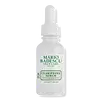What's inside
What's inside
 Key Ingredients
Key Ingredients

 Benefits
Benefits

 Concerns
Concerns

No concerns
 Ingredients Side-by-side
Ingredients Side-by-side

Water
Skin ConditioningPropanediol
SolventButyloctyl Salicylate
Skin ConditioningAzelaic Acid 15%
BufferingPolyglyceryl-6 Stearate
EmollientGlycerin
HumectantPolyglyceryl-4 Oleate
EmulsifyingAvena Sativa Kernel Flour
AbrasiveGlyceryl Caprylate
EmollientSodium Anisate
AntimicrobialSodium Levulinate
Skin ConditioningPolyglyceryl-6 Behenate
Emulsion StabilisingRosa Canina Fruit Extract
AstringentCetyl Hydroxyethylcellulose
Emulsion StabilisingXanthan Gum
EmulsifyingSodium Phytate
Aloe Barbadensis Leaf Juice
Skin ConditioningCamellia Sinensis Leaf Extract
AntimicrobialWater, Propanediol, Butyloctyl Salicylate, Azelaic Acid 15%, Polyglyceryl-6 Stearate, Glycerin, Polyglyceryl-4 Oleate, Avena Sativa Kernel Flour, Glyceryl Caprylate, Sodium Anisate, Sodium Levulinate, Polyglyceryl-6 Behenate, Rosa Canina Fruit Extract, Cetyl Hydroxyethylcellulose, Xanthan Gum, Sodium Phytate, Aloe Barbadensis Leaf Juice, Camellia Sinensis Leaf Extract
Water
Skin ConditioningLactobacillus Ferment Lysate
Skin ConditioningGlycerin
HumectantAloe Barbadensis Leaf Juice
Skin ConditioningPotassium Azeloyl Diglycinate
Skin ConditioningHydroxyethyl Acrylate/Sodium Acryloyldimethyl Taurate Copolymer
Emulsion StabilisingAzelaic Acid
BufferingInulin
Skin ConditioningPolyacrylate Crosspolymer-6
Emulsion StabilisingPhenoxyethanol
PreservativeScutellaria Baicalensis Root Extract
AstringentMagnolia Officinalis Bark Extract
AntimicrobialBetaine
HumectantPolysorbate 20
EmulsifyingChlorphenesin
AntimicrobialAlpha-Glucan Oligosaccharide
CleansingCaprylyl Glycol
EmollientAmmonium Acryloyldimethyltaurate/Vp Copolymer
Sodium PCA
HumectantSodium Lactate
BufferingSodium Sulfite
PreservativePCA
HumectantLactic Acid
BufferingHydrolyzed Sodium Hyaluronate
Skin ConditioningSerine
MaskingSodium Benzoate
MaskingAlanine
MaskingSodium Chloride
MaskingGlycine
BufferingPolyglycerin-6
HumectantGlutamic Acid
HumectantLysine Hcl
Skin ConditioningThreonine
Arginine
MaskingPotassium Sorbate
PreservativeOrthosiphon Stamineus Leaf Extract
Skin ConditioningHydroxyacetophenone
AntioxidantProline
Skin Conditioning1,2-Hexanediol
Skin ConditioningCitric Acid
BufferingWater, Lactobacillus Ferment Lysate, Glycerin, Aloe Barbadensis Leaf Juice, Potassium Azeloyl Diglycinate, Hydroxyethyl Acrylate/Sodium Acryloyldimethyl Taurate Copolymer, Azelaic Acid, Inulin, Polyacrylate Crosspolymer-6, Phenoxyethanol, Scutellaria Baicalensis Root Extract, Magnolia Officinalis Bark Extract, Betaine, Polysorbate 20, Chlorphenesin, Alpha-Glucan Oligosaccharide, Caprylyl Glycol, Ammonium Acryloyldimethyltaurate/Vp Copolymer, Sodium PCA, Sodium Lactate, Sodium Sulfite, PCA, Lactic Acid, Hydrolyzed Sodium Hyaluronate, Serine, Sodium Benzoate, Alanine, Sodium Chloride, Glycine, Polyglycerin-6, Glutamic Acid, Lysine Hcl, Threonine, Arginine, Potassium Sorbate, Orthosiphon Stamineus Leaf Extract, Hydroxyacetophenone, Proline, 1,2-Hexanediol, Citric Acid
 Reviews
Reviews

Ingredients Explained
These ingredients are found in both products.
Ingredients higher up in an ingredient list are typically present in a larger amount.
Aloe Barbadensis Leaf Juice comes from leaves of the aloe plant. Aloe Barbadensis Leaf Juice is best known for helping to soothe sunburns. It is also anti-inflammatory, moisturizing, antiseptic, and can help heal wounds.
Aloe is packed with good stuff including Vitamins A, C, and E. These vitamins are antioxidants, which help fight free-radicals and the damage they may cause. Free-radicals are molecules that may damage your skin cells, such as pollution.
Aloe Barbadensis Leaf Juice also contains sugars. These sugars come in the form of monosaccharides and polysaccharides, folic acid, and choline. These sugars are able to help bind moisture to skin.
It also contains minerals such as calcium, 12 anthraquinones, fatty acids, amino acids, and Vitamin B12.
Learn more about Aloe Barbadensis Leaf JuiceAzelaic acid is a multitasker ingredient that helps treat acne, pigmentation, and irritation. It is a great option for sensitive skin.
What makes azelaic special?
The best thing about azelaic acid is it's gentleness. It's generally well-tolerated and safe to use alongside other actives like niacinamide or salicylic acid.
Unlike AHAs, azelaic acid will not make you photosensitive/sun sensitive.
You can find this ingredient naturally occurring in grains like wheat, rye, and barley. In cosmetics, azelaic acid is typically lab-made, which is more stable and effective.
Learn more about Azelaic AcidGlycerin is already naturally found in your skin. It helps moisturize and protect your skin.
A study from 2016 found glycerin to be more effective as a humectant than AHAs and hyaluronic acid.
As a humectant, it helps the skin stay hydrated by pulling moisture to your skin. The low molecular weight of glycerin allows it to pull moisture into the deeper layers of your skin.
Hydrated skin improves your skin barrier; Your skin barrier helps protect against irritants and bacteria.
Glycerin has also been found to have antimicrobial and antiviral properties. Due to these properties, glycerin is often used in wound and burn treatments.
In cosmetics, glycerin is usually derived from plants such as soybean or palm. However, it can also be sourced from animals, such as tallow or animal fat.
This ingredient is organic, colorless, odorless, and non-toxic.
Glycerin is the name for this ingredient in American English. British English uses Glycerol/Glycerine.
Learn more about GlycerinWater. It's the most common cosmetic ingredient of all. You'll usually see it at the top of ingredient lists, meaning that it makes up the largest part of the product.
So why is it so popular? Water most often acts as a solvent - this means that it helps dissolve other ingredients into the formulation.
You'll also recognize water as that liquid we all need to stay alive. If you see this, drink a glass of water. Stay hydrated!
Learn more about Water